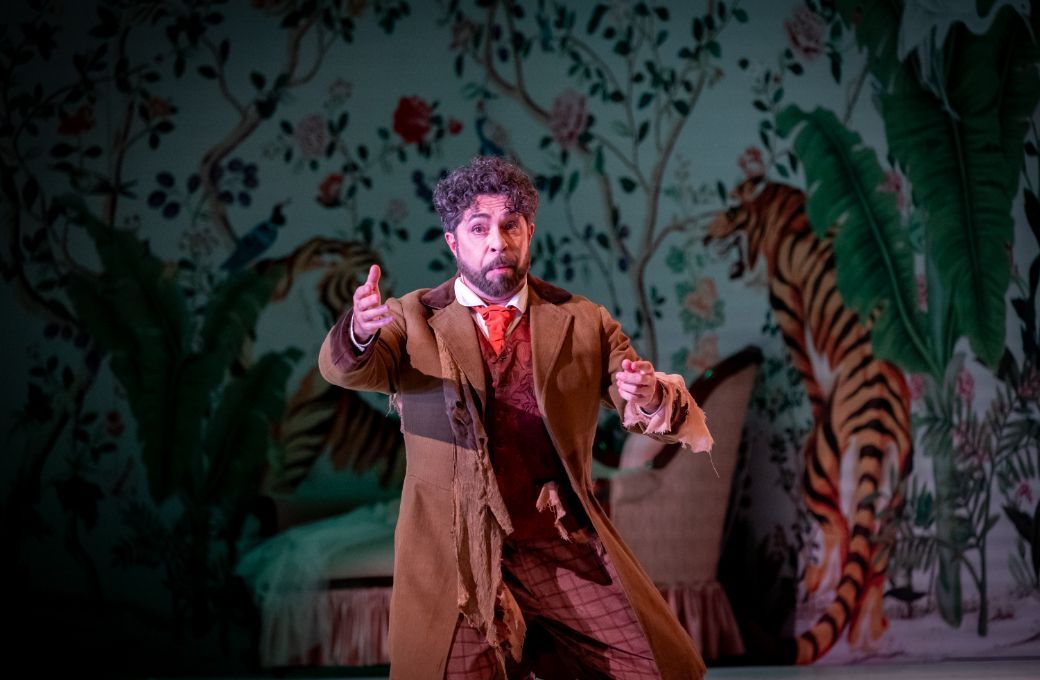From Lucia di Lammermoor to I puritani, bel canto operas are littered with ‘mad scenes’. The vast majority of the victims are sopranos, of course, but the furioso (mad man) in Donizetti’s Il furioso nell’isola di San Domingo is a baritone and he begins the opera already in a state of insanity. It’s a problematic work to stage – set in the 16th century on an island in the West Indies, the plot features a black slave, Kaidamà – and most opera companies give it a wide berth.

Not so Donizetti Opera, which last staged it here in Bergamo only twelve years ago and entrusts this successful new production to director Manuel Renga to complete the festival’s opening weekend.
Jacopo Ferretti’s libretto draws on an episode in Cervantes’ Don Quixote. Spanish merchant Cardenio – the furioso – has been driven mad by the betrayal of his wife and has taken up solitary refuge on an island. His repentant wife, Eleonora, turns up (via a shipwreck) to make amends, which sends Cardenio spiralling into further turmoil. His brother, Fernando, also arrives, just in the nick of time to rescue Cardenio, who has thrown himself off a cliff into the sea. A near miss suicide pact with a couple of pistols later, the mental fog clears and Cardenio and Eleonora are reconciled.
Renga does a very sensitive job, not least around the issue of dementia. As a framing device, we see an elderly Cardenio (Andrea De Manincor) looking, with his bushy white beard, not unlike Giuseppe Verdi. He is in a nursing home, being given his medication, and clutches his wedding photograph to his chest. The island setting is a box set lined with tropical plant wallpaper. In the care home we see the old man drawing on the wall, visited by his elderly wife, whom he does not recognise. As the drama plays out, he is a frequent observer, often coming face to face with his younger self.
Aurelio Colombo’s designs have a quirky look. The characters seem less Spanish and more late Victorian England – all bustles and boaters – trekking across the island as if on a bracing walk along the pier. Fernando arrives emerging from a wardrobe and Eleonora makes an appearance, fully clothed, in a bathtub with a bubble machine in overdrive. In the Act 1 finale, Cardenio’s mental state is depicted by having all the props suspended on flywires.
Apart from a tempest which can’t hold a candle to Rossini, Donizetti’s score is hugely attractive, with some wonderful arias and cabalettas, a fine sextet and a rousing Act 1 finale. The clarinet solo introducing Cardenio’s long mad scene is eloquent and the vocal writing for the baritone is really distinguished.
As such, the opera stands or falls by the baritone taking on the title role and here, alas, this performance came a cropper. Paolo Bordogna, not so long ago touted as the major new buffo talent, had a performance to forget, beset by intonation problems. That’s not to deny his convincing acting and commitment to the role, but this was a huge disappointment.
Nino Machaidze suffered a few blustery moments as Eleonora, but her soprano gleamed in her big numbers. Santiago Ballerini’s bright, pingy tenor made a positive impression as Fernando and Bruno Taddia clowned his way through Kaidamà’s role like a barrow boy out of the East End (at least his make-up was black stubble rather than blackface). Lyric bass Valerio Morelli lent gravitas to Bartolomeo and Giulia Mazzola sang with warm soprano tone as his daughter, Marcella, who is sympathetic to Cardenio’s plight.
Conductor Alessandro Palumbo could have been more responsive towards his cast, sometimes racing away from the singers in his urgency, but the Donizetti Opera Orchestra turned in another spirited performance.
Mark's press trip was funded by the Fondazione Donizetti


